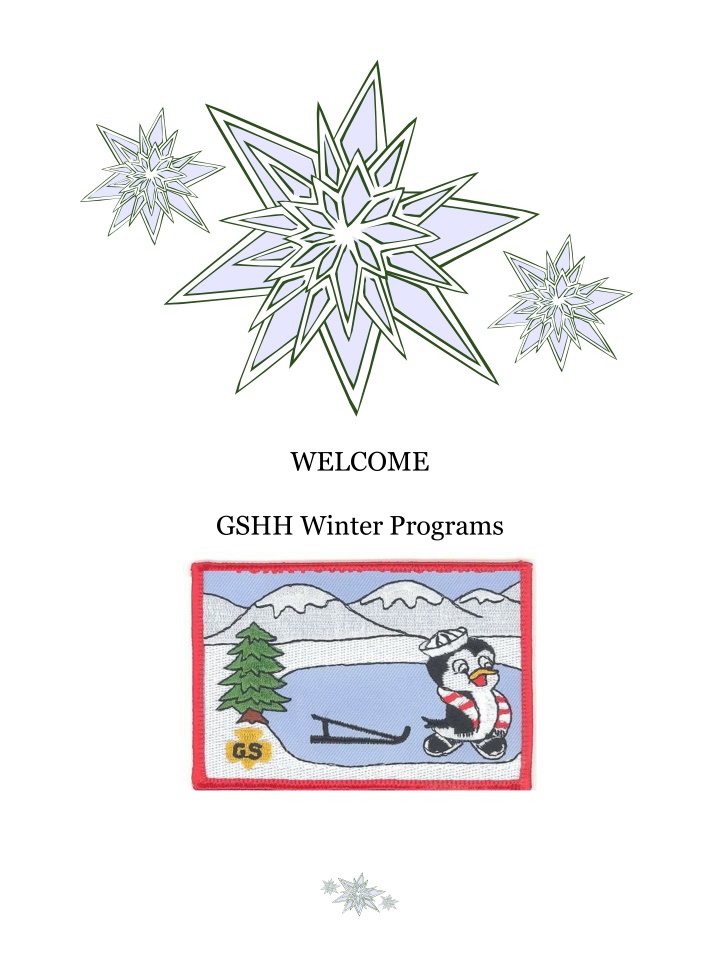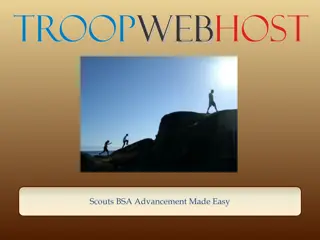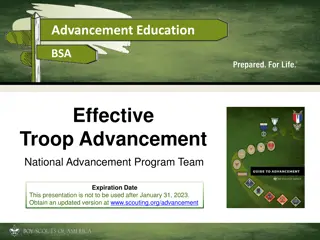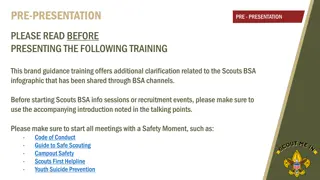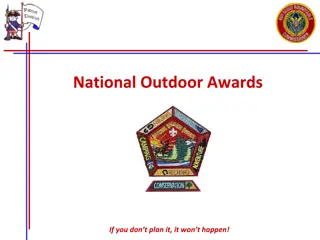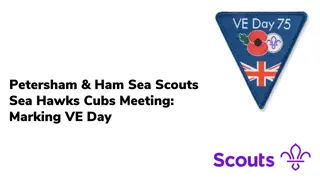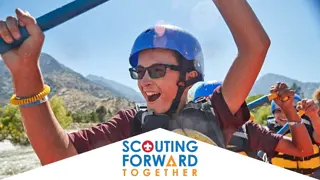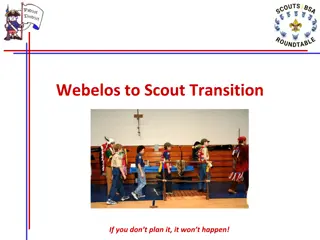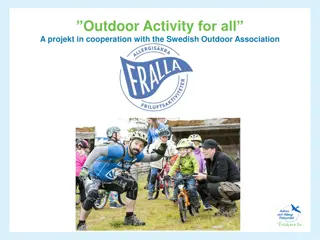Exciting Winter Outdoor Adventures with Girl Scouts Heart of the Hudson
Girl Scouts Heart of the Hudson is offering three thrilling winter programs for Cadettes, Seniors, Juniors, and 6th Grade Cadettes. From a Klondike Survival Derby to a Polar Bear Overnight, participants will experience challenging outdoor activities that require special planning and specific equipment. The programs aim to test survival skills, outdoor knowledge, and teamwork in a winter setting. Proper clothing and equipment are crucial for safety and enjoyment. Don't miss out on these unforgettable winter adventures!
Download Presentation

Please find below an Image/Link to download the presentation.
The content on the website is provided AS IS for your information and personal use only. It may not be sold, licensed, or shared on other websites without obtaining consent from the author.If you encounter any issues during the download, it is possible that the publisher has removed the file from their server.
You are allowed to download the files provided on this website for personal or commercial use, subject to the condition that they are used lawfully. All files are the property of their respective owners.
The content on the website is provided AS IS for your information and personal use only. It may not be sold, licensed, or shared on other websites without obtaining consent from the author.
E N D
Presentation Transcript
WELCOME GSHH Winter Programs
This winter Girl Scouts Heart of the Hudson has three all day or overnight outdoor adventures that need special planning on your part if you want to join the adventure. We are offering: https://encrypted-tbn3.gstatic.com/images?q=tbn:ANd9GcTphdK6AouiJOkI3JzvF0lMik0-eV2jliwF95IgssEiJp5PwXl4 Klondike Survival Derby (Rock Hill) January 20, 2018 Cadettes, Seniors and Ambassadors A winter survival adventure. Rock Hill Camp will be transformed into the Alaskan Yukon where Girl Scouts will be traversing the frontier from town to town and mountains to shore testing their survival skills as they compete for golden nuggets. Do you have the skills to survive? Can you shoot an arrow through a hole in a tree? Can you out smart your fellow competitors and win the golden nuggets? -------------------- https://encrypted-tbn2.gstatic.com/images?q=tbn:ANd9GcQ44B1hXWi_Dc9qY6R8heH0xOoKDYHfkE-QJGeQtuiylsBXTptdpg Polar Bear Overnight (Rock Hill) January 20, 2018 (start 4:00 p.m.) Cadettes, Seniors and Ambassadors Winter camping is fun and challenging. For those few hardy souls who come and brave the freezing winter weather in just a tent, we offer the GSHH Polar Bear Award. -------------------- Jr. Klondike Exploration (Camp Addisone Boyce) February 3, 2018 9:30 AM to 3:00 PM Juniors and 6th Grade Cadettes While spending lots of time outdoors, we will build winter shelters, test our fire-making skills and learn the best technique to build and hoist a location signal in case we ever get lost.
Polar Bear Overnight Personal Equipment and Clothing Packing list Listed below are the items that are required for this specialized program. Please review the information and decide which items are already available, which could be borrowed and which may have to be purchased. Please do not wait until the last minute; it is up to you to have all the required equipment. For safety concerns, if you arrive without the correct equipment and/or clothing, you will be asked to leave. Camping in the winter can be a lot of fun, however, you must always be prepared to deal with severe winter weather. Everything on the following list is there for a reason, and the number one reason is for your safety Please make sure you read through the additional information about proper winter clothing and layering provided at the end of this presentation. Clothing Two pair non-cotton underwear wear one, put one in overnight bag/backpack One non-cotton mid-layer shirt wear one (if you sleep cold, pack one extra in overnight bag-optional) Two pair non-cotton long underwear shirt and pants wear one pair, pack one pair One non-cotton mid-layer pants wear (if you sleep cold, pack one extra pair, optional) Polar Fleece vest for over mid-layer shirt (optional but helpful) One heavy woolen, fleece or acrylic shirt/sweater Three pair non-cotton socks - wool or acrylic blend wear one pair during the day, put one pair in day pack, and pack one pair in overnight bag (you must change your socks before going to bed) Three pair silk or nylon sock liners Two pair water proof winter mittens/gloves One pair lighter gloves to work/cook in (these should be something that will protect your hands from the cold but are flexible enough to prepare food) One or two pair silk or nylon glove liners (optional but helpful) One pair waterproof ski/snow pants - wear (watch the weather; if there is a chance of wet snow or weather, a second pair of ski/snow pants will be needed) Warm waterproof winter jacket/parka One fleece neck gator or scarf Sturdy, waterproof, insulated snow boots (not hiking boots) Two warm winter wool, fleece or acrylic blend hats that cover your ears - wear one, put one in day pack (you must have a hat to sleep in) Rain gear -- make sure you can cover up; if you get wet, there is almost no way to stay warm
Personal Equipment - (Polar Bear Overnight) A great attitude and positive team spirit One hands free day pack One (only one) overnight bag 4 season sleeping bag - check label/manufacture for temperature rating. (NO summer/spring sleeping bags). It is for YOUR SAFTY that we require a winter sleeping bag. A dangerous and possibly life threatening condition called *hyperthermia can occur during the night while you are sleeping if you do not have the correct equipment and clothing. Warm comforter to lay on top of your sleeping bag NOTE: The sleeping bag and comforter can be packed in a second bag; they do not need to fit in the overnight bag. One plastic sheeting ground cloth at least 6 x4 One camping sleeping pad (not blow up mattress) to use under sleeping bag Pillow Toilet articles - Keep it simple; we will be using latrines. No regular bathrooms/wash houses will be available. To be packed in Day Pack (Polar Bear Overnight) Mess kit or plastic plate/cup/bowl (make sure the cup is easily used with hot beverages) Plastic fork/spoon/knife Flashlight head lamp works very well (extra batteries) Simple jackknife Full reusable water bottle Hand warmers and foot warmers 2 large black garbage bags Space Blanket (can be purchased at Wal-Mart or any outdoor equipment store) Bandanna Lip balm Energy bar or GORP Matches and small piece of a candle in a waterproof bag Camera (optional) Please remove all jewelry (whether covered by clothing or not) before arriving at camp. * Hypothermia is a potentially dangerous drop in body temperature, usually caused by prolonged exposure to cold temperatures. Normal body temperature averages 98.6 degrees. With hypothermia, the bodies core temperature drops below 95 degrees, which will cause serious health risks.
Jr. Klondike Exploration February 3, 2018 9:30 AM to 3:30 PM Klondike Exploration is for Juniors and 6th Grade Cadettes. While spending lots of time outdoors, we will build winter shelters and learn other various survival methods to stay warm and dry. We will test our fire-making skills in the snow or wet and cold ground, and learn the best technique to build and hoist a location signal in case we ever get lost. Bonus: we will also learn about ice safety and hypothermia and how to stay safe outdoors in the winter. We will pick up strategies of staying warm by playing Klondike Derby games and other activities. Our Jr. Klondike Exploration program is a base level winter survival program dedicated to teaching survival skills and knowledge that can be used when camping, hiking or during any prolonged exposure to cold, especially during the winter. Girls/troops do not need prior experience or training to attend the Klondike Exploration program. They will, however, learn how to take care of themselves in the outdoors and come away with a new sense of appreciation of outdoor winter safety and fun. All the skills learned during the Klondike Exploration program directly relate to our Klondike Survival Derby offered to girls in 6th-12th grade. Girls/troops must adhere to the required clothing and equipment list. Anyone (including leaders and parents) who do not dress appropriately will be asked to leave for their own safety. Please make sure you read through the additional information about proper winter clothing and layering provided at the end of this presentation. Poor Planning often results in unsafe camping and hiking along with damage to our natural resources. Park rangers and emergency rescuers often tell stories of campers and hikers they have encountered who, because of poor planning and unexpected conditions, degrade the trails and many times put their lives and their rescuers lives at risk. Why is planning and dressing properly for an outdoor experience so important? It helps ensure your safety. It prepares you to Leave No Trace and minimizes trail and camping area damage. It contributes to accomplishing our adventure s goals safely and enjoyably. It increases self-confidence and opportunities for learning more about nature.
Jr. Klondike Exploration Clothing and Equipment List Clothing to wear the day of the program Wool or synthetic blend socks (plus one extra pair in your daypack) NO COTTON SOCKS Waterproof insulated snow/ski pants or waterproof windproof ski pants with mid- layer pants Snow/ski warm winter jacket Mid-layer wool/fleece jacket or sweater Insulated snow boots (not hiking boots) Wool or synthetic blend winter hat that covers your ears Winter insulated waterproof gloves/mittens (plus extra pair in your day pack) Neck gator or scarf tucked in Thermal underwear, top and bottom (non-cotton type) Please bring the following in a hands-free daypack Bag Lunch Energy bar or GROP (trail mix-no peanuts) Refillable water bottle Plastic mug for Hot Chocolate/soup Plastic spoon Candle stub (whole candle not needed) Clean tuna fish can (no label) Note: So that you do not overheat and begin to perspire when traveling to camp, please remove your jacket, hat, gloves and scarf while in the car. Perspiration will cause your clothing to get wet; being wet in the outdoors during the winter is dangerous.
Outdoor Clothing Information for GSHH Outdoor Winter Programs Nothing compares to the crisp, clean air of winter and the magnificent view of a snowy landscape. But any outdoor adventure, even a day at camp, requires careful planning and the right gear. Always check the weather and prepare for the worst conditions. The best way to be protected from the weather from head-to-toe during the winter is to wear layers. Enjoying our winter camp day to the fullest extent requires knowing how to dress. With the right clothes, a winter s day at camp with friends while exploring new challenges can be a magical experience. But, unprepared, that day might leave you recalling a shivering, wicked-cold day and maybe even health problems. The following list of clothing is designed to share advice and know-how for staying warm outdoors in the winter. When thinking about layering, please remember that as you exercise (hike, play, build shelters etc.), your body heats up and you do not need as much insulation. As a matter a fact, it is dangerous to get over heated in the winter because then you sweat, causing your clothing to get wet. We layer ourselves in the winter to help us stay cool when being active as much as staying warm. Dress Like and Onion - Pinkham Lodge Ready Room Click to enlarge
Types of Layers We list the different types of layers, which can be used in combination with each other to reach the ideal effect for the season, environment, and activity you are pursuing. These layers work together to achieve the four goals of wicking moisture, trapping in heat, insulating from cold and blocking wind and weather. When considering what to wear as you layer, anything made of cotton should not be used. The reason cotton is an absolutely terrible choice for winter weather is because cotton has little insulation value AND because it absorbs and then holds moisture. Worse yet, when a garment made of cotton gets wet, it loses ALL insulation value. Since being wet is a recipe for getting very cold very fast; cotton garments should never be considered when engaging in outdoor winter activities! Base Layer The base layer is the layer closest to your skin, meaning it collects the most sweat. The purpose of this layer is to keep you dry by pulling moisture away from your skin and spreading it throughout the fabric. At the same time this fabric should fit snugly and retain some insulating properties. Never wear cotton as layer, it does wick moisture, but then retains that moisture as the cotton loses its resiliency, loses its warmth, and causes too much evaporative cooling. There are two main categories of base layers: synthetic and wool. Synthetic layers are polypropylene (fleece like) or polyester long underwear, the benefits of which are that they are not itchy, tend to be less expensive than wool, are more durable, and dry faster. Wool base layers are made primarily out of merino wool, which is thin and lightweight, less itchy than traditional wool, and does not retain stench. Although wool takes longer to dry than synthetics, it continues to insulate well even when wet. Either type of material is fine for all our winter programs at camp. Mid-Layer The purpose of the mid-layer is to capture warmth through trapped air. Typically a mid-layer is a fleece or a thick wool layer. A mid-layer usually has some loft to it to help trap the warm air, but is also breathable so it is not suffocating and sweat-causing underneath a shell or outer layer. Sometimes, particularly in the three-piece layering system, a mid-layer can also be an insulating layer such as a thin synthetic or down puffy. We recommend a zip-neck or a full zip mid-layer to make it easier to regulate heat.
*Insulation Layer An insulation layer, whether synthetic or down, provides extra loft and warmth, essentially doing what a thick mid-layer does, but multiplied, and with a much higher warmth-to-weight ratio. Size your insulated layer jacket to fit comfortably over a light fleece (mid-layer) and underneath an outer waterproof shell. When the weather is dry, your insulated layer may be worn as an outer layer, keeping you warm around the campsite, or for extra warmth between activities. Most normal ski/snow jackets we use for winter outdoor activities combines this Insulation Layer with the outer layer. *Outer Shell The primary function of a shell is to protect you from the elements when conditions take a turn for the worst. An alternative to a separate Outer Shell is a jacket system mentioned above that combines the insulation layer with a shell. For example, most ski jackets take this approach since it is both less expensive and more convenient to have both layers combined. Similarly, some heavy winter jackets combine a thick insulation layer and a shell layer into a completely weatherproof winter coat. Most ski jackets are water resistant but not water proof. No matter what layering system you chose you always want to pack waterproof raingear as your final layer, which will protect you from both rain and wind in extreme weather. *With normal winter wear, many times the insulation layer and the outer shell are the same winter jacket. Snow/Ski Pants We talked about shirts and jackets above. Please remember the layering system is also needed for the lower body. Base layer (after cotton underpants) long under- wear, insulated snow/ski pants and a waterproof outer shell is also needed.
Winter Socks: When spending time outdoors in winter weather while participating in camping and derby activities, a quality winter sock should be worn. The importance of wearing the right sock in winter weather cannot be understated. Wearing the latest, greatest and most expensive winter boot will do little to combat cold feet if you are wearing cotton socks. So, what do you wear for a sock during the winter? For cold weather, a sock made of wool, IsoWool, shearing, fleece or similar types of synthetic materials should be used. The reason these types socks are excellent for winter wear is because if the socks get wet (due to excessive perspiration from the foot or from rain/snow), the socks themselves do not lose their insulating properties. Additionally, these socks are also generally far thicker than a standard thin cotton sock, allowing the sock to absorb far more moisture. Moreover, and one of the neatest features of these types of socks, is that they can actually dry themselves out by simply being worn. The body heat of a person can actually dry out these types of socks. Sock Liners The sock liner is probably the most forgotten about asset in keeping your feet dry in cold weather. A sock liner pulls double duty both by adding in some extra insulation value (although it is very marginal) as well as by effectively transferring perspiration from the foot directly to the sock that the person wears. In essence, a sock liner takes the water off your foot and moves it to the sock with the sock liner itself remaining perfectly dry (due to the construction of these types of socks). Because of transfer of moisture off the foot to the sock, your feet remain perfectly dry (even during periods of great exertion), thus greatly increasing the probability of keeping your feet warm.
Winter Gloves Gloves/mittens for outdoor winter activities should be constructed with three layers a waterproof outer shell, an insulation layer all the way to the fingertips (down feathers or a synthetic like Primaloft), and an inner liner that can wick away moisture. Some winter gloves/mittens come with all three layers; but if you purchase or own gloves without the liner layer, you can purchase glove liners separately. Since we will be active during our winter programs gloves/mittens with liners that can be removed in case you start to sweat work best. Snow Boots A snow boot is a boot designed for use in the snow, as the name suggests. However, a snow boot is also designed to be used in wet conditions, too. The reason snow boots excel in these conditions is due to their design. A good pair of snow boots generally has a rubber bottom providing 100% waterproof protection. The upper part of a snow boot will be either made of leather, rubber or a mix of leather and nylon. The upper part of a snow boot will frequently extend well above the ankle. The reason for this is that snow boots generally have a built-in snow gator of some kind. The snow gator closes the space between your lower leg and the opening of the boot thus preventing snow from falling down inside the boot when you happen to be wandering through deep snow. A snow boot is designed to provide warmth and protection of the foot in really nasty weather. However, if the proper sock combination is not worn in a snow boot, the foot itself can become rather wet due to the inability of the foot perspiration to escape the lower rubber shell of the boot.
KLONDIKE DERBY Saturday, January 20th, 2018 Rock Hill Camp Stations First Aid The Dining Hall will be First Aid Headquarters. A nurse will be on duty all day. HEADQUARTERS FORT YUKON Each patrol leader and assistant patrol leader check in at Headquarters with clipboard and pencil. Individual girls or Juliettes check in at Headquarters and join up with other girls to form a patrol. Activity: issue Passport give patrol leader a map show girls starting point give patrols order to visit stations pick up garage bag. Note: Girls should go around to the stations by themselves. Any adult helping at a station is 50% off the patrol s score. Each troop MUST provide two leaders to help out at the event. Individual girls must be accompanied by an adult who also will be asked to help. Adults should dress properly for outdoor winter weather. Adults will be at the stations and positioned around the camp to assist the Mayors and the girls with any problems (not helping with testing skills at the stations). There should be enough adults so that we can rotate them and give each adult some time to warm up in the dining hall. Coffee and hot chocolate are available for adult helpers all day.
1. INSPECTI0N STATION - JUNEAU Activity: inspect patrol or Juliette (individual) for required list of equipment collect service project check sled list patrol on station s records give patrol Passport and gold nugget Equipment Per Patrol/Troop If troop is larger than eight girls, we suggest you divide the girls into two patrols. Each patrol should have the following equipment. Sled First Aid Kit (see First Aid page for supplies/equipment needed) Ground cloth (sheet, tarpaulin, etc.) Matches Tinder/Kindling/Fuel Wood (Dry in Plastic bag) - enough to build a fire 6 Pieces of rope each eight feet (clothes line) 2 Gallons of water 1 Ziploc bag or pouch 3 Six-Foot Wooden Staffs, 1 -2 diameter (6th-8th grades) 5 Six-Foot wooden Staffs, 1 -2 diameter (9th-12th grades) Blanket Clipboard and pencils 1 lb metal can NOT PLASTIC (9th-12th graders) Equipment Per Juliette (Individual Scout girls not competing with a troop) First Aid Kit (see First Aid page for supplies/equipment needed) Ground cloth (sheet, tarpaulin, etc.) Matches Tinder/Kindling/Fuel Wood (Dry in Plastic bag) enough to build a fire 6 Pieces of rope each eight feet long (clothes line) 1 Gallon of water 1 Ziploc bag or pouch 1 Six-Foot Wooden Staffs, 1 -2 diameter
Inspection (contd) Equipment Per Girl Scout Lunch and snack Service Project for homeless: package of men s white socks OR pair of men s large winter gloves OR a warm blanket Appropriate personal clothing/gear any girl wearing inappropriate clothing/boots will be sent home wool or synthetic blend socks (plus one extra pair) NO COTTON SOCKS waterproof insulated snows/ski pants or waterproof windproof ski pants with mid layer pants mid-layer wool/fleece jacket or sweater (dress in layers) wool or synthetic blend winter hat that covers your ears winter insulated waterproof gloves/mittens (plus extra pair) neck gator or scarf tucked in thermal underwear, top and bottom (non-cotton type) boots (no high heel boots or sneakers) Mug for hot drink 2 Trash bags (33 gallons or larger) Situpon Extra pair of warm socks in Ziploc bag (no cotton socks) Toe warmers/hand warmers Girl Scout Spirit Scoring: Points for items, girl scout spirit and being properly dressed.
For the Klondike Survival Derby Each Team Must Have a Sled to Carry Their Team s Gear There are directions on line about how to make an official Klondike Derby sled. The team sleds will not be part of the judging so an official Klondike Derby sled is not needed. All that matters is that your team has a sled that will carry the mandatory gear. Below are pictures of homemade sleds of all types which we found online. The secret is building a sled with balance (won t tip over when full) with lines long enough so EVERYONE can help pull. Sleds as simple as a few milk crates attached to a pair of skis have worked well in the past. The teams would fill the crates with equipment and then attach large/long supplies to the side of the crates with bungee cords. The key is to pack the sled so all of the equipment can easily be taken on and off when needed. There is much information on line about making a homemade sled. I have included a picture of a true Klondike Derby Sled (which is part of the competition with the Boy Scouts). Ask around; maybe a Boy Scout troop in your area will loan you a sled. Picture of the Klondike sled http://builtbykids.com/sneak-peek-our-diy-ski-sled/ Above Boy Scout Klondike Derby Sled http://wintertrekking.com/wp-content/uploads/2011/10/IMG_0548_resize.jpg http://wintertrekking.com/wp-content/uploads/2011/10/IMG_0132_resize.jpg http://wintertrekking.com/wp-content/uploads/2011/10/IMG_0574_resize.jpg
2. FIRE BUILDING SKAGWAY ***NO LIQUID FIRE STARTERS*** Mayor: A. 6th-8th Grade Activity: Build a proper fire (6 flame) boil water and extinguish fire Reference Materials: Outdoor Education in Girl Scouting pp. 54, 56-58 Scoring: 10 points wood and formation fire starter used flame Boiling water safety hair back, fire properly extinguished girl scout spirit B. 9th-12th Grade Activity: Build a proper fire (6 flame), cook a meal and extinguish fire. More information about the meal will be emailed to you. Reference Materials: Outdoor Education in Girl Scouting pp. 54, 56-58 Scoring: 10 points wood formation fire starter used flame meal creativity and cooking difficulty safety hair back, fire properly extinguished girl scout spirit
3. EMERGENCY SHELTER ATTU Mayor: A. 6th-8th Grade Activity: Construct a shelter using natural items and terrain with materials provided. Patrol enters shelter. Patrol disassembles shelter and makes sure area is returned to natural state. Scoring: 10 points group effort creativity protection from ground and the elements soundness of structure girl scout spirit B. 9th -12th Grade Activity: Same as above except 9th-12th grade girl scout must lash two poles together to raise a flag. Use the lashing shown below. Scoring: 10 points group effort creativity protection from ground and the elements soundness of structure lashing and raising flag girl scout spirit Round Lashing: Place two poles side by side. Put a clove hitch around both poles. Make 8 or 10 wrappings around both poles. No frappings. Finish with a clove around both poles.
4. KNOTS AND LASHINGS (two levels) POLAR COVE Mayor: A. 6th-8th Grade NOTE: Each girl should know how to tie the knots. Only one or two will have to demonstrate. The Mayor of Polar Cove will pick which girls will tie each knot. Scoring: 10 points girl scout spirit square knot clove hitch two half-hitches bowline square lashing Reference Materials: Outdoor Education in Girl Scouting pp. 54, 56-58 See attached description of knots and lashings. B. 9th-12th Grade Build an A frame. Be able to carry a girl from the patrol on it. Use the poles and rope you brought with you. Lashings: diagonal, square and round. Scoring: 10 points girl scout spirit square lashing diagonal lashing round lashing able to transport girl
5. FIRST AID - DEADMANS GULCH Mayor: Jeanne Farrell Activity: Tested on general first aid skills including hypothermia signs and symptoms, treatment and prevention carbon monoxide poisoning frostbite/frostnip trenchfoot/emersion foot snow blindness dehydration splint a broken arm make a stretcher and carry victim several feet. Equipment Per Patrol Ziploc gallon size bag for supplies bandaides antiseptic wipes triangular bandage (2) safety pins space blanket gauze pads (2 and 4 ) bandage tape popsicle sticks for splints protective disposable gloves (2 pair) ace bandage scissors roller gauze instant ice pack Equipment Per Juliette (Individual Scout) Ziploc gallon size bag for supplies bandaides antiseptic wipes triangular bandage (2) safety pins space blanket gauze pads (2 and 4 ) bandage tape popsicle sticks for splints protective disposable gloves (2 pair)
6. GEOCASHING MOOSE PASS Mayor: Melissa Cole Activity: No preparation required. All skills will be taught and then a challenge presented to the girls. SWAPS (Special Whatchamacallit Affectionately Pinned Somewhere) - four per girl Supplies: Scoring: 10 points What Is A Swap Swaps are the perfect way for Girl Scouts to meet each other and promote friendship. Each one is a memory of a special event or Girl Scout Sister. Swaps Basics Swaps: tell something about the givers or their group may include address or e-mail or troop number should represent the givers' country, community, or local Girl Scout council Tips for Swaps Givers Girls should: think about the kind of swap they would like to receive from someone else try not to spend a lot of money making it consider making something from donated or recycled material be creative and take time to make hand-crafted swaps
7. TEAMWORK I (two levels) A. 6th-8th Grade NOME Mayor: Colleen Walsh Activity: No preparation required. Girls will be given a problem to solve. Points are given for teamwork, solution to the problem and girl scout spirit. Scoring: 10 points B. 9th -12th Grade Mayor: Jim Liucci Activity: 9th-12th grade girl scouts will be shown how to handle a pocketknife and use a hatchet, single bow saw and a two person bow saw. Girls will then be given a challenge. Scoring: 10 points teamwork being able to use equipment safety girl scout spirit
8. ARCHERY SO TRUE THE ARROW, SO STEADY THE HAND Mayor: Activity: Each member of the team will step up and set her sights on the game. Tensions mount as archers shoot for the chance to win points for their Klondike team. Everyone will be taught the basics of how to safely shoot an arrow accurately. Each member of the team will have the opportunity to shoot. Scoring: 10 points stance and form safety rules shooting accuracy
GENERAL Time Schedule The girls have approximately 20 minutes for each station or town. The twenty minutes includes travel. Please tell them they should watch the time and try not to fall behind or race ahead. Be sure one person in the patrol is wearing a watch. Individual Girls/Juliettes Activity Troops 08:50 09:20 Form Patrols/Get Acquainted Registration Station #1 Station #2 Station #3 Station #4 Station #5 Lunch Station #6 Station #7 Station #8 Station #9 Fort Yukon scoring clean-up scavenger hunt hot chocolate 09:20 09:40-10:00 10:00-10:20 10:20-10:40 10:40-11:00 11:00-11:20 11:20-11:50 11:50-12:10 12:10-12:30 12:30-12:50 12:50-01:10 09:40-10:00 10:00-10:20 10:20-10:40 10:40-11:00 11:00-11:20 11:20-11:50 11:50-12:10 12:10-12:30 12:30-12:50 12:50-01:10 01:40 approximate Awards 01:40 approximate Lunch Each patrol eats at the Town they are in at 11:20 a.m. (30 minutes for lunch). Each patrol must eat lunch in a Town in front of a Mayor to be scored. They will be judged on having lunch with them, something hot (hot chocolate, soup), clean up and girl scout spirit. Lunch must be eaten outdoors unless otherwise instructed. Clean Up Use garbage bags for picking up litter and trash seen along the way and your own litter. Extra points given at the end for this. Bags will be provided at registration. (4 points) Scoring Each adult troop leader must check addition of the stations and record on total page BEFORE patrol turns in Passport.
FIRE-MAKING MATERIALS FIREWOOD INSTRUCTION SHEET 1. FIRE STRATERS 2. TINDER 3. KINDLING MATCHES Kitchen size are best. Waterproof with paraffin or nail polish. GRASS Fine, dry up off the ground. TWIGS Dead, dry wood from standing trees. WEED TOPS Goldenrod, aster, etc. WEED STEMS Medium and heavy stems FLINT AND STEEL Any stone containing quartz is good. For steel, use back of knife blade or file with burr ground off. DRY LEVES Still on the tree. SPLIT WOOD Always good as long as it is dry split fine enough more than you think you need FINE TWIGS Squaw wood from standing trees. FIRE BY FRICTION Cottonwood, cedar, elm, or basswood for board and spindle. BARK Cedar or birch or palmetto picked from dead standing trees with your fingernails. 4. FUEL BURNING GLASS Magnifying glass or lens of binoculars or camera. WOOD Any size. Better split it if your log is more than 3 in diameter. BIRD NESTS From last season. NOTE: Troops will use matches for Klondike fire challenge. MOUSE NESTS From any season. CHARCOAL In natural sticks or pressed briquetts. PAT PINE Full of pitch COAL Soft or hard. FINE SHAVINGS of dry wood PAPER CANDLE
